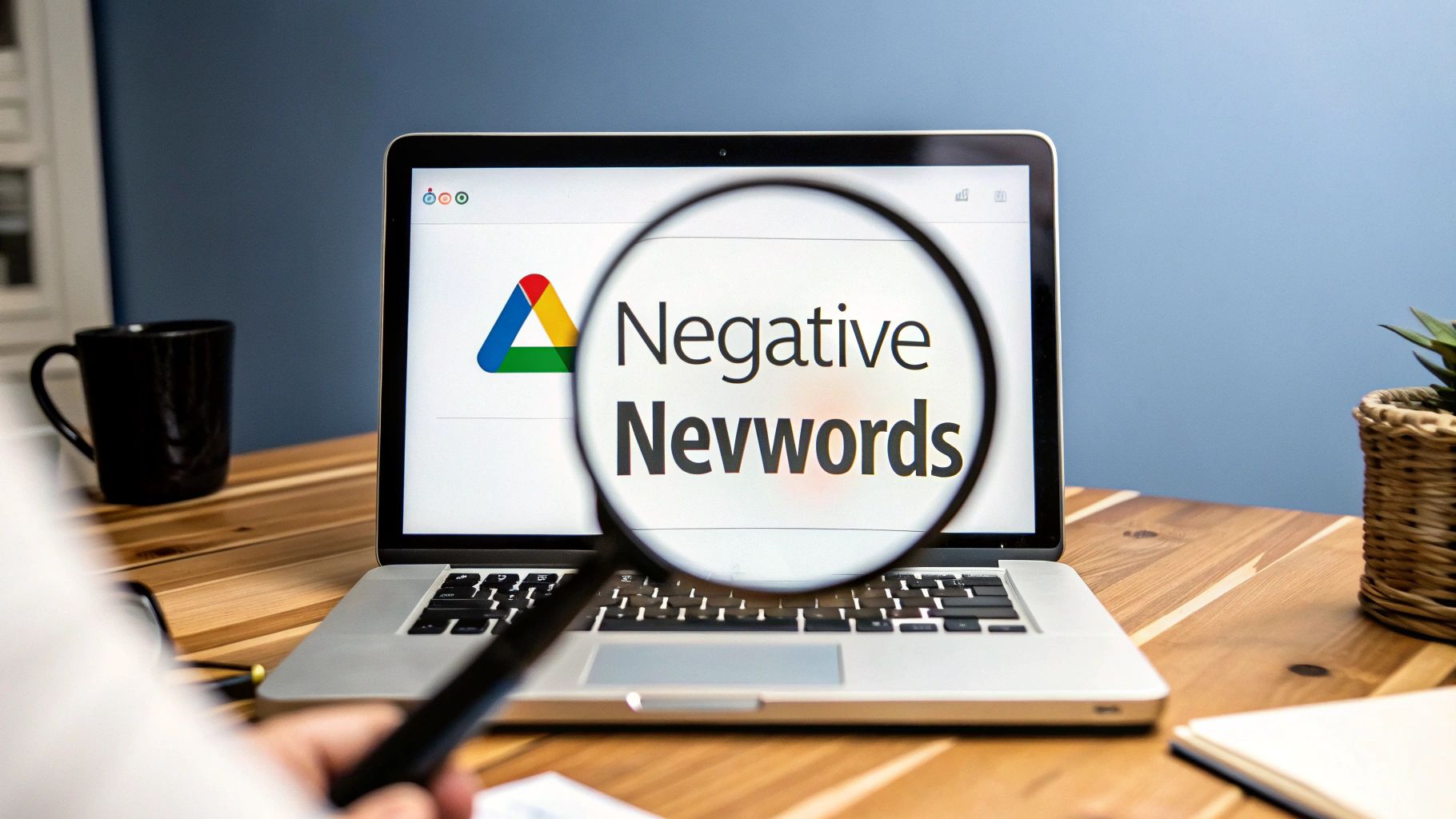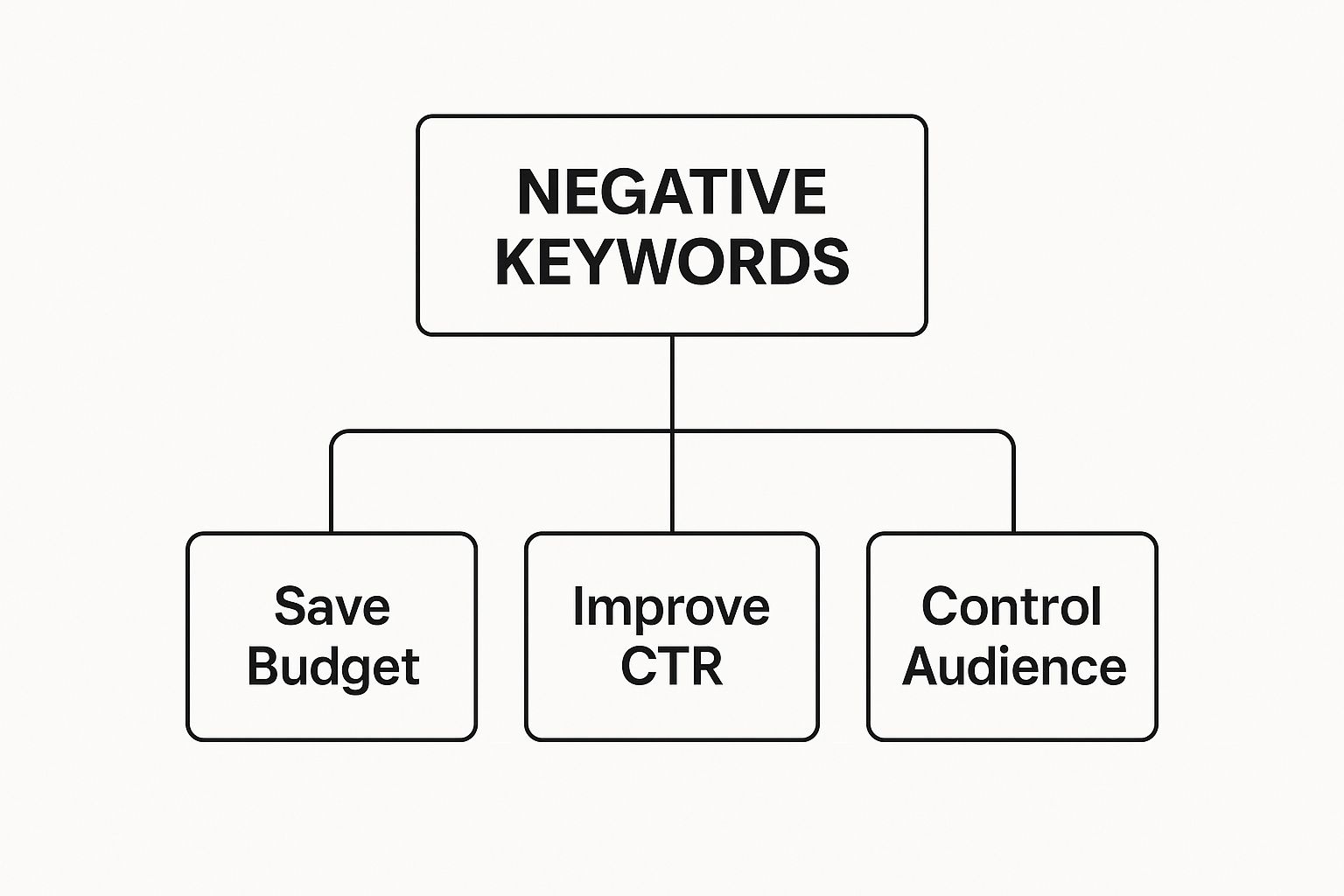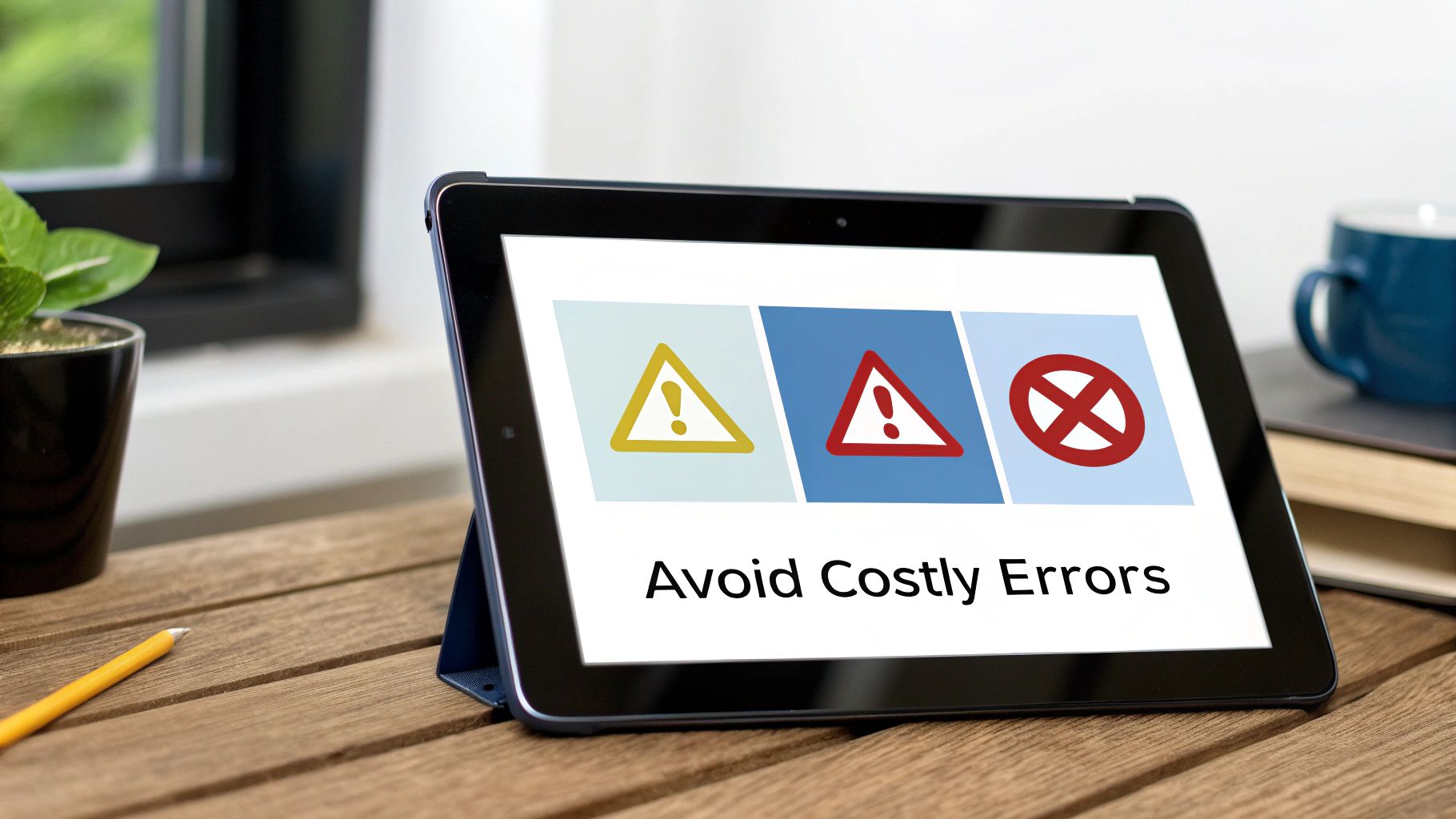October 20, 2025
A Guide to Google AdWords Negative Keywords


Running a Google Ads campaign without negative keywords is like fishing with a giant net in the open ocean. You'll catch something, but most of it will be junk you have to sort through. In PPC, that wasted effort is your hard-earned ad budget going down the drain.
Negative keywords are your secret weapon against this. They're basically a "do not show" list for Google, telling it which searches are a terrible match for your ads.
What Are Negative Keywords and Why Do They Matter?
Let's get straight to it. Negative keywords are the gatekeepers of your ad budget. They act as filters, telling Google precisely which search terms are not a good fit for your business. By adding them, you sharpen your targeting so only people with real buying intent see your ads.
The Core Purpose of Negative Keywords
Think about it like this: say you sell premium "men's leather dress shoes." You absolutely do not want your ad popping up when someone searches for "free shoe repair" or "jobs at shoe stores."
Even though the word "shoe" is in there, the searcher's goal is completely different from what you offer. By adding negative keywords like "free," "repair," and "jobs," you stop your ad from showing up for those searches. You save yourself a costly, pointless click.
This isn't just a minor tweak; it's fundamental to running a profitable campaign. You stop paying for traffic that was never going to convert anyway. A solid negative keyword strategy is the bedrock of effective adwords keyword optimization.
Visualizing the Benefits of Control
This infographic really drives home the key advantages of getting your negative keywords right.

As you can see, it's a domino effect. One simple action—adding negatives—directly improves your budget efficiency, click-through rate, and the overall quality of people visiting your site.
Properly managing your ads is key to success. For those looking for expert assistance, exploring comprehensive Google Ads services can ensure your campaigns are managed efficiently from the start.
The Impact on Campaign Performance
The results speak for themselves. Campaigns that actively manage their negative keyword lists see a 10–20% lower wasted spend on irrelevant clicks. This higher-quality traffic often leads to conversion rate improvements of 5% to 15%, especially in crowded markets.
The bottom line is simple: Every dollar you save on an irrelevant click is another dollar you can invest in a click that converts. Negative keywords are your first line of defense against wasted ad spend.
How to Find the Right Negative Keywords

Alright, you get why you need google adwords negative keywords. But now for the million-dollar question: where do you actually find them? The best way to think about this is less like a chore and more like a treasure hunt. You're digging for clues that will lead you to a leaner, meaner, more profitable campaign.
The good news is that Google basically hands you the map. Your number one tool for this mission is a powerful, yet often forgotten, part of your Google Ads account.
Mine Your Search Terms Report for Gold
Your first and most important stop is always the Search Terms Report. This is where Google shows you the actual search queries people typed in right before they clicked your ad. It’s like a direct window into your customer's brain—and it’s an absolute goldmine for finding irrelevant terms that are quietly draining your budget.
Flying blind is a terrible strategy in paid search. If you're not checking this report, you're just trusting Google to match your ads to whatever it thinks is best, and that's a surefire way to waste money. Regularly digging into this data is the single most effective habit you can build for a strong negative keyword list.
If you want to get really good at this, check out our deep-dive guide on the Google Ads Search Terms Report. It breaks down the whole process step-by-step.
How to Systematically Review Search Terms
Don't just skim the report. You need a system. Sifting through it methodically will reveal patterns of wasted spend you can plug up in minutes.
Look for High Impressions, Low Clicks: A search term that triggers your ad a ton but gets almost no clicks is a huge red flag. It’s a clear signal that your ad has nothing to do with what that searcher actually wants. Adding it as a negative will immediately boost your Click-Through Rate (CTR).
Identify Zero-Conversion Clicks: This is the painful one. Find the terms that are getting clicks (and costing you money) but have never, ever led to a conversion. These are often the biggest budget leeches and should be added as negatives on sight.
Spot Completely Irrelevant Terms: This is the low-hanging fruit. If you sell "luxury dog beds" and see clicks coming from searches for "cheap dog food," you’ve found a perfect candidate for your negative list.
Following this simple three-step process helps you systematically clean up your traffic. It ensures your ad spend is only going toward queries that have a real shot at turning into business.
Proactive Discovery Before You Spend a Dime
The Search Terms Report is fantastic for reacting to what’s already happened, but you can also get ahead of the game. Proactive discovery is all about thinking like a potential customer—and anticipating the searches you don't want to show up for.
Don't wait for bad clicks to tell you what's wrong. A little proactive brainstorming can prevent wasted ad spend before it even happens, giving you a crucial head start on campaign optimization.
Start by brainstorming categories of terms that signal the wrong kind of searcher for your specific business.
Common Non-Buyer Terms to Consider
- Informational Queries: Words like "how to," "what is," "free," and "tutorial" almost always signal someone looking for information, not looking to buy.
- Employment Searches: Unless you're actually hiring, terms like "jobs," "careers," "hiring," and "salary" will attract job seekers, not customers.
- Competitor Names: Do you really want to pay for a click from someone specifically searching for your biggest rival? Adding competitor brand names can often save a surprising amount of money.
- DIY or Cheap Alternatives: If you offer a premium service, words like "DIY," "cheap," "used," "discount," or "template" will attract bargain hunters who were never going to be your customer anyway.
This proactive approach, combined with regular dives into your Search Terms Report, creates a powerful one-two punch. You'll not only clean up past mistakes but also build a strong defense against future wasted spend.
Using Negative Keyword Lists to Stay Organized
Finding the right google adwords negative keywords is a great first step, but what you do with them is what really counts. If you just start dumping every new negative into individual campaigns, you’re creating a management headache that’s impossible to keep up with. This is where Negative Keyword Lists are a lifesaver—they're your secret weapon for keeping things organized and under control.
Imagine adding negatives one by one. It's like putting a single sticky note on every file in a giant filing cabinet. A Negative Keyword List, on the other hand, is like creating one master folder labeled "DO NOT TOUCH" and applying that rule to entire sections of the cabinet all at once. It's cleaner, faster, and way more effective.
The Power of Shared Lists
Instead of micromanaging negatives at the campaign or ad group level, shared lists let you create a single, central list of exclusions that you can apply to multiple campaigns at the same time. When you add a new term to that list, the change instantly ripples across every single campaign it’s attached to.
This isn't just about being neat; it's about strategic consistency. It makes sure every campaign is protected from the same junk traffic, building a rock-solid foundation of efficiency across your whole account. For a deeper dive, our guide on how to use negative keyword lists offers a full walkthrough.
Building Your Core Negative Keyword Lists
You don't need a dozen different lists to be effective. For most advertisers, just two core types of lists will get the job done, each serving a different strategic purpose.
Account-Level "Universal" List: This is your master list of words you never want to show up for, period. It's your first line of defense against guaranteed wasted clicks. Think of terms related to job-seeking ("careers," "hiring"), research ("how to," "what is"), or just plain wrong intent ("free," "torrent," "download").
Theme-Specific Lists: These are more focused and apply to specific product lines or services. For instance, if you sell high-end "leather briefcases," you might create a list for that campaign theme that blocks terms like "cheap," "used," "synthetic," or "vegan leather." This gives you granular control without cluttering up your universal list.
By separating your lists this way, you create a structure that just makes sense. The screenshot below from Google's own documentation shows you exactly where to manage these lists in the "Tools and Settings" menu.

This centralized "Negative keyword lists" section is your command center for keeping your account tidy and efficient.
Respecting Google's Limits
As you start building out these lists, it’s good to know the platform's limitations so you can prioritize what really matters. You have to be strategic with your exclusions, especially as your account gets more complex.
A well-organized negative keyword list is more than just a collection of unwanted terms; it's a scalable system that grows with your business, ensuring every new campaign you launch is instantly protected from known waste.
Officially, Google Ads has a limit of 5,000 negative keywords per campaign-level list. This cap is there to help advertisers filter out bad queries without bogging down the system. While there have been whispers of this limit increasing, the official number still stands, which means you have to be smart about what makes the cut. This is just one more reason why building smart, themed lists is so important—it helps you stay within the guardrails.
Navigating Negative Keywords in PMax Campaigns
Performance Max (PMax) campaigns are a huge part of the Google Ads toolkit these days. They're powerful and packed with automation, but for many advertisers, they still feel like a black box. For a long time, managing PMax felt like handing Google the keys to your car and just hoping it ended up in the right place.
The old PMax model gave us almost no control. Initially, our only real lever was an account-level negative keyword list—a clumsy tool that couldn't be tailored to specific campaigns. Thankfully, things have gotten better. Google now allows for campaign-level negatives, which gives us a bit more say in where our ads show up.
But there's a critical detail here that a lot of advertisers miss, and it often creates a false sense of security.
The Big Limitation Everyone Overlooks
Here’s the catch with google adwords negative keywords in PMax: they only apply to a small slice of the PMax network. When you add a negative keyword to a Performance Max campaign, it only stops your ads from showing on Search and Shopping inventory.
That’s it.
Your negative keywords do absolutely nothing to prevent your ads from popping up across the rest of the PMax network. This means they have zero impact on your placements in:
- Display
- YouTube
- Gmail
- Discovery
This is a huge deal. A ton of wasted ad spend in PMax comes from these other channels, where the context is often murky and user intent is way lower. So, while you might feel like you're plugging all the leaks by adding negatives, you're really only patching up part of the problem.
Setting Realistic Expectations for PMax
Understanding this limitation is the key to managing both your budget and your sanity. You absolutely should add negative keywords to your PMax campaigns to weed out irrelevant search queries. It's a crucial step for improving performance on the channels you can actually control.
Think of PMax negative keywords as a filter for your most high-intent traffic (Search and Shopping), not as a firewall for your entire campaign. Acknowledging their limits is the first step toward a smarter PMax strategy.
This focused control is still valuable. Google recently increased the Performance Max negative keyword limit to 10,000 per campaign, giving us more room to refine our targeting where it really counts. Still, their overall effectiveness is a hot topic. Because these exclusions don't touch Display, YouTube, Gmail, or Discovery, some studies suggest they only reduce budget waste by about 15–25%. It helps, but it's not a silver bullet, as you can read more about in this breakdown of PMax negative keyword effectiveness.
How to Maximize Your Control
Even with these restrictions, you aren't powerless. To get the most out of PMax, you just have to pull the levers that are actually available to you.
Use Campaign-Level Negatives: Be proactive. Add negatives to block irrelevant searches and shopping queries just like you would for a standard Search campaign. Make a habit of regularly reviewing whatever search term data Google gives you.
Leverage Brand Exclusions: If PMax is starting to cannibalize your branded search traffic, use the brand exclusion feature to tell the algorithm to back off and let your dedicated brand campaigns do their job.
Refine Your Asset Groups: Make sure your ad copy, images, and videos are super relevant and tightly themed. This gives Google's AI much clearer signals about who you're trying to reach, which can indirectly help reduce irrelevant placements everywhere.
By combining these tactics, you can steer your PMax campaigns in the right direction and squeeze more performance out of them, even with the built-in limitations.
Common Negative Keyword Mistakes to Avoid
Using negative keywords can completely turn your account around, but a few simple mistakes can just as easily sabotage your results. Think of this as your guide to dodging the most common traps that end up wasting ad spend and blocking valuable traffic.
Getting this right is all about building a smarter, more deliberate strategy from day one.

So many advertisers dive in with the best intentions but end up making really costly errors. We're not talking about complex technical blunders here—these are often simple oversights that have a massive impact on your campaign's health and, ultimately, your bottom line.
By getting a handle on these pitfalls ahead of time, you can build a much more resilient and efficient campaign that saves you money and a lot of headaches down the road.
Using The Wrong Match Types
This is easily the biggest and most expensive mistake you can make. Adding a broad match negative keyword when you really meant to use an exact match is like using a sledgehammer when you need a scalpel. You’ll end up blocking way more traffic than you intended, including some of your best high-converting, long-tail searches.
Let's say you sell "premium running shoes" but want to stop showing up for people looking for "free running shoes."
- The Mistake: Adding running shoes as a broad match negative.
- The Result: You've just told Google Ads to block your ads from showing on any search containing "running shoes," including super profitable queries like "best cushioned running shoes for marathons." Your campaign just went dark.
- The Fix: Use a phrase match negative "free running shoes" or an exact match negative [free running shoes] to block that specific query without killing your core traffic.
Forgetting About Conflicts
A common slip-up is creating a conflict where a negative keyword straight-up cancels out one of your targeted keywords. This happens more often than you'd think, especially in large accounts with multiple campaigns and ad groups all drawing from the same lists.
The result is simple: your ad will not show. Google’s system will always prioritize the negative keyword, effectively shutting down your positive keyword.
A negative keyword will always win in a conflict with a positive keyword. Regularly auditing for these conflicts is crucial to ensure you're not accidentally preventing your best ads from being seen by your ideal audience.
Imagine you're bidding on the phrase match keyword "men's leather wallet" but have added leather as a broad negative in a shared list used by a different campaign. You’ve just created a direct conflict that stops your ad dead in its tracks. Always check for overlaps before adding broad negatives to shared lists.
Falling For The "Set It and Forget It" Mindset
Treating your negative keyword list like a one-time setup task is a recipe for missed opportunities. Search behavior changes constantly, new irrelevant terms pop up every week, and your own business goals evolve.
Your negative keyword lists need to be living, breathing documents that adapt right alongside your campaigns.
A term that was irrelevant last quarter might become highly relevant this quarter because of a new product launch or a shift in market trends. Regularly reviewing your search terms report isn't just about finding new negatives to add; it's also about spotting opportunities and making sure your old negatives aren't holding you back.
A quick audit every few weeks can prevent you from blocking good traffic and keep your campaigns performing at their peak.
We've all been there—a small oversight in your negative keyword list can quickly snowball into a major problem. Here’s a quick guide to help you spot and fix some of the most common blunders before they drain your budget.
Negative Keyword Mistake and Fix
Remember, a little proactive maintenance goes a long way. Regularly checking for these issues will keep your campaigns clean, efficient, and profitable.
Building a Negative Keyword Strategy That Lasts
Managing your google adwords negative keywords isn't a "set it and forget it" kind of deal. It's a living, breathing part of keeping your campaigns healthy and profitable. Think of it less as a task to check off and more as a simple, repeatable routine you build into your workflow.
It’s like tending a garden. You can’t just plant the seeds and walk away, expecting a perfect harvest. You have to pull weeds consistently. In this case, the "weeds" are those junk search terms that choke your budget and hide your ads from the right people.
Finding Your Rhythm: The Regular Review
The absolute heart of a lasting strategy is regularly checking your Search Terms Report. This isn't a once-in-a-blue-moon activity; it needs to be a non-negotiable part of your schedule. For most accounts, a weekly or bi-weekly check-in is the perfect cadence.
This routine lets you spot and block irrelevant queries before they eat up too much of your ad spend. It's all about consistency. Making it a habit turns you from a reactive manager putting out fires to a proactive strategist keeping your campaigns clean and efficient from the start.
Your Simple Account Maintenance Checklist
To keep things straightforward, here's a quick checklist to run through during your scheduled reviews. This helps you cover all your bases, ensuring you’re not just adding new negatives but also fine-tuning what you already have in place.
- Hunt for New Junk: What new, irrelevant search terms have popped up since your last check? Add them to the right negative keyword list.
- Audit Your Existing Lists: Take a quick look at your current negative lists. Has your business changed? A negative from six months ago might actually be relevant now if you’ve added a new product or service.
- Check for Friendly Fire: Make sure a new negative keyword isn't accidentally blocking a positive keyword you’re actually bidding on. It happens more than you'd think!
- Look at Performance: Did your click-through rate or conversion rate suddenly jump (or dip) after adding a bunch of negatives? Use that feedback to guide your next move.
A great negative keyword strategy is really just a simple, continuous loop: discover, implement, review, and refine. This cycle is your best defense, making sure your campaigns are always adapting to how real people search and protecting your budget 24/7.
This ongoing process of refinement is what separates the okay campaigns from the truly great ones. It means you're constantly steering your account toward better performance and higher profits, not just reacting when things go wrong.
Frequently Asked Questions
Even with a solid game plan, you're going to have questions about the finer points of Google Ads negative keywords. Nailing these details can make a huge difference in your campaign's performance, so let's tackle a few of the most common head-scratchers.
Think of this as your quick-reference guide for those tricky situations that pop up when you're deep in the trenches managing your account. These are the practical, everyday questions that come up time and time again.
How Many Negative Keywords Should I Add?
Honestly, there's no magic number. The right amount depends entirely on your situation—the size of your account, how broad your keywords are, and how much junk traffic you're seeing in your search terms report. A small, super-niche account might only need a couple hundred negatives, while a massive e-commerce store could easily have thousands.
A better question to ask is, "Am I regularly adding the right negative keywords?" It's about consistency, not sheer volume. A weekly habit of adding just five to ten high-impact negatives that you know are wasting money is way more valuable than dumping 500 random words in once and calling it a day for the next six months.
Can Negative Keywords Ever Hurt My Campaign?
Oh, absolutely. But only if you get sloppy. The biggest mistake I see is people getting too aggressive with broad match negatives. For instance, if you sell "wood furniture" and you add wood as a broad match negative, you've just told Google to kill your ads for pretty much every relevant search out there.
The most common way to shoot yourself in the foot is by creating a conflict where a negative keyword blocks a positive keyword you’re actively bidding on. Always, always double-check for these conflicts so you don't accidentally make your own ads invisible.
This is why being precise is so important. Stick with phrase and exact match negatives whenever you can. Only use broad match for terms you are 100% certain you never, ever want to show up for—think universal stuff like "jobs" or "free."
What's The Difference Between a Campaign and Ad Group Negative?
Think of it in terms of control. Adding a negative keyword at the ad group level is like using a scalpel—it gives you the most precise control. It only blocks that term for that specific ad group, which is perfect when you have products with similar names but totally different uses. For example, you might add "kids" as a negative to an ad group for "pro running shoes" but definitely not to your ad group for "back to school shoes."
A campaign-level negative is more like a sledgehammer. It applies that exclusion to every single ad group within that campaign. This is your go-to for blocking terms that are universally irrelevant to that entire product line or service, saving you the headache of adding the same negative to a dozen ad groups one by one. It’s a broader, more efficient filter.
Ready to stop wasting time and money on bad clicks? Keywordme turns tedious negative keyword management into a one-click process. Clean up your search terms, build powerful negative lists, and optimize your campaigns up to 10x faster—all without ever leaving your Google Ads screen. Start your free 7-day trial and see the difference.


.svg)